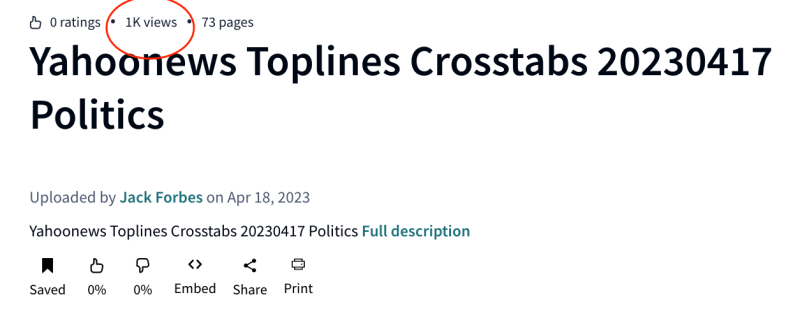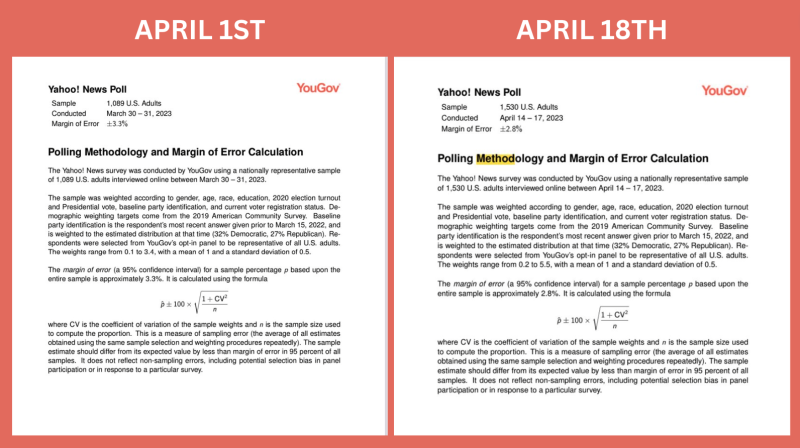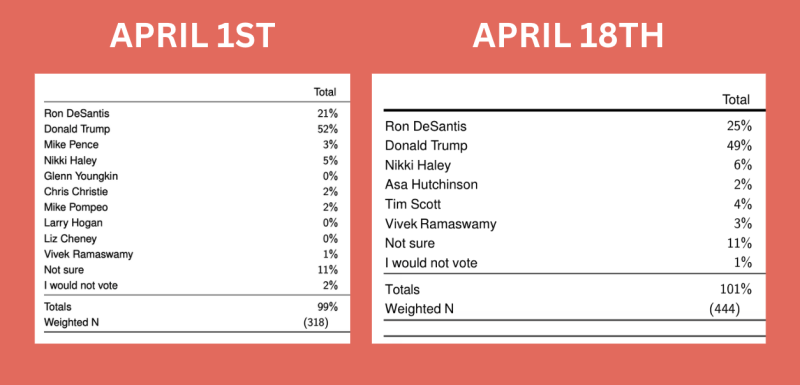Corporate media has been championing a “Trump fades fast” poll while neglecting to mention drastic alterations in methodology, weightings, sample size, margin of error, and even the candidates on offer, The National Pulse can reveal.
Yahoo News, National Review, the New York Post, Time magazine, Fox News and others have been celebrating a new YouGov poll which claims Donald Trump’s “big post-indictment bounce is fading fast”. At first glance, the data could look quite concerning for Trump supporters. A deeper read, however, reveals disturbing polling industry practices designed to mislead both reporters and the public.
They'll grin and read you the top lines but they won't tell you about the underlying data… pic.twitter.com/HWd7UfCqYo
— Raheem. (@RaheemKassam) April 20, 2023
Crosstabs.
“Crosstabs” are the data itself, in detail, rather than the “top lines” you hear about on the news. More reputable firms release cross tabs alongside the top lines, unlike recent polling that sought to hide such things from public scrutiny. The cross tabs for the latest Yahoo/YouGov poll can be found here, viewed just 1,000 times despite the stories themselves racking up millions of clicks across a variety of news sites:

This level of detail allows us to compare the previous YouGov data (April 1st) against the latest information released on April 18th. Here’s what we learn, in brief:
- April 1st’s poll sampled 1,089 U.S. adults, while April 18th’s sampled 1,530;
- April 1st’s poll had a margin of error of 3.3%, while April 18th’s showed 2.8%;
- April 1st’s poll had a weight range of 0.1 to 3.4, while April 18th’s was 0.2 to 5.5;
- April 1st’s poll gave respondents 10 Republican choices, while April 18th’s provided just six options.
Weight a Minute!
While sample sizes changes and even margins of error shift from poll to poll, the weighting as well as the difference in candidate choices is critical to understanding why the results drastically differ over the course of a few weeks – arguably far more so than any actual material change in people’s perceptions of the candidates or their likelihood of voting for them.
In the first poll, of a smaller sample size, the weighting ranged from 0.1 to 3.4. In layman’s terms, this means if someone (or some people) are deemed to be under-represented in the sample, their answers receive weighting to make them count for more. Typically, one would expect weighting to narrow as the sample size increases. But in the second, larger poll, the weighting range actually increases to 0.2 to 5.5.
All of which is to say, someone (or some people) in the second poll are being given a special boost. And I suspect that is occurring within the category of Independents, which I elaborate upon further below.

Detailed Head-to-Head.
The head-to-head numbers between Trump and DeSantis look odd.
Upon first glance you might look at April 18th’s numbers (Trump 52, DeSantis 36) and conclude that Trump is in free fall. He was up 57 vs DeSantis’s 31 just three weeks prior.
And while of course there would be a post-indictment bump and subsequent easing, the drastic changes deeper in the data raise more questions about the weighting and methodology than they raise about candidate viability and support.
An example: on April 1st, Trump carried 58 percent of Republicans and 50 percent of Independents according to YouGov. By April 18th, he carried 56 percent of Republicans (margin of error changes are hardly intriguing) but dropped to 34 points amongst Independents. That’s a 16-point drop in one group in just a few weeks. Not only unheard of barring some major scandal, but total madness when you get even further into the data. Remember, while we discuss percentage points, the raw numbers can make this even more farcical.
Raw Numbers.
In raw numbers, the polls respectively surveyed just 54 and 82 Independents on the same question: “If your state’s 2024 Republican primary for president were held today, who would you vote for? Donald Trump or Ron DeSantis?”
On the first survey, 50 percent, or 27 people, chose Trump, and 22 chose DeSantis. This five-person difference accounted for the 10 percentage point difference. Of the 82 surveyed Independents on April 18th, Trump took 28 people, and DeSantis landed on 39. Originally, 10 percent (5 people) were unsure. The second time around, 15 percent (12 people) were unsure.
Which means, in real terms, that while Trump gained one person, he dropped 16 percentage points (12 people) in the poll as a result.
Furthermore, amongst Republicans, Trump had 58 percent (144 people) vs DeSantis’s 28 percent (69 people) on April 1st, compared to 56 percent (195 people) vs DeSantis’s 33 percent (115 people). Those “not sure” went from 13 to 11 percent.
And these are the ways pollsters trick you.
With subtle shifts in weighting, sample sizes, and candidate choices on offer, the needle moves quite significantly on the “top line” information. That bubble bursts when you start reading between the lines.
The only takeaway from the survey is that 22 Independent voters had stronger feelings in favor of Donald Trump immediately after the indictment. The statisticians will assure you this is significant, given their methodologies (especially the weighting they apply to the other paltry numbers).
I suggest they reflect nothing more than natural ebb-and-flow at best, and statistical deception at worst.
Different Candidates.
While fields can change, it is strange that without much actually changing in the real world, Yahoo and YouGov decided to remove several candidates from its list of April 1st, namely: Glenn Youngkin, Mike Pence, Chris Christie, Mike Pompeo, Larry Hogan, and Liz Cheney. They added Asa Hutchinson and Tim Scott.
The Pompeo change makes sense since the former CIA director ruled himself out in the past week, and the Hutchinson and Scott additions also make sense given their increased profile for the job. But the changes materially impact across the board, and make it almost impossible to make direct poll-to-poll comparisons.
For instance, Ron DeSantis picked up 4 points, Nikki Haley picked up one, and Vivek Ramaswamy picked up two. Trump, we’re told, dropped three. This means 10 points shifted around, with Trump only accounting for less than a third of this movement. The rest is just moderate Republicans or Independents who previously fancied mostly Pence, Christie, and Pompeo shifting to DeSantis, Haley, and Ramaswamy. And remember, in raw terms, this can mean one or two people changing their preference, and skewing the poll, especially if their answer is heavily weighted.

People readily regard polling data which doesn’t track well as “outlier” or “freak” incidents. In this instance, the comparison between the two data sets is just wildly bad reporting.
Readers can look at the cross tabs for April 1st here, and April 18th here.

